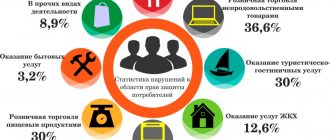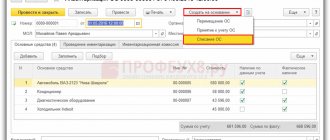Criteria for assigning a tax audit
There are 12 criteria for an on-site tax audit, on the basis of which tax inspectors plan on-site audits. The more matches there are in the parameters, the higher the likelihood of assigning a control measure.
Entrepreneurs and organizations that meet all the criteria are most likely to be included in the plan of on-site audits initiated by the tax service.
Important numerical indicators are the tax burden (criterion 1) and the level of profitability (criterion 11), which are updated every year.
Scheduled on-site tax audits
This is due to the fact that the inspectorate prepares for an on-site inspection in advance and checks a significant period of the taxpayer’s activities. However, if you think that an on-site tax audit will definitely take place in your company 3 years after the start of work, then this is not so.
The resources of tax authorities are limited and, in a situation where tens of thousands of taxpayers are registered with each inspection in Moscow, it is clear that on-site inspections cannot cover all organizations
.
Therefore, for a more effective selection of companies for on-site inspections, a number of criteria have been developed to select companies subject to on-site inspections.
Some of these criteria are open in nature and you can familiarize yourself with them in the letter “On the criteria for self-assessment of risks for taxpayers used by tax authorities in the process of selecting objects for conducting on-site tax audits.”
The most common criteria for inclusion in an on-site inspection plan are:
- The tax burden of this taxpayer is below its average level for business entities in a specific industry (type of economic activity). The tax burden is calculated as the ratio of the amount of taxes paid according to the reporting of tax authorities and the turnover (revenue) of organizations according to the Federal State Statistics Service (Rosstat).
- Reflection in tax reporting of significant amounts of tax deductions for a certain period. Significance is determined as follows: the share of value added tax deductions from the amount of tax accrued from the tax base is equal to or exceeds 89% for a period of 12 months.
- Repeatedly approaching the maximum value of indicators established by the Tax Code of the Russian Federation that grant taxpayers the right to apply special tax regimes.
Regarding special tax regimes
the approach (less than 5%) to the maximum value of the indicators established by the Tax Code of the Russian Federation that affect the calculation of tax for taxpayers applying special tax regimes (2 or more times during a calendar year) is taken into account.
Regarding the simplified taxation system
– repeated approach to the limit values established by Articles 346.12 and 346.13 of the Tax Code of the Russian Federation of indicators necessary for the application of the simplified taxation system:
- The share of participation of other organizations is no more than 25 percent;
- The average number of employees for the tax (reporting) period, determined in the manner established by the federal executive body authorized in the field of statistics, is no more than 100 people;
- The residual value of fixed assets and intangible assets, determined in accordance with the legislation of the Russian Federation on accounting, is no more than 100 million rubles;
- The maximum amount of income determined based on the results of the reporting (tax) period in accordance with Article 346.15 and subparagraphs 1 and 3 of paragraph 1 of Article 346.25 of the Tax Code of the Russian Federation is no more than 60 million rubles.
So, after the tax inspectorate has determined that your organization meets these criteria, the tax authorities need to justify the estimated amount of additional assessments for the on-site audit. At the same time, the plan for on-site inspections is a sealed secret and, unlike inspections of firefighters, labor inspectors, etc., the plan for on-site inspections is never published in open sources
.
Therefore, organizations, as a rule, learn about an on-site inspection at the time they receive a decision to conduct an on-site inspection
. At the same time, in most cases, the decision is not handed over, and you only sign that you are familiar with such a decision.
However, often, you can find out about an upcoming audit by indirect signs, since the tax inspectorate conducts a pre-audit analysis before including it in the audit plan.
In particular, to collect information about the company, the tax office sends requests about cash flows in bank accounts, uses open sources of information, etc. Therefore, if your bank reported that a request has been received for information on cash flows, this is a sure sign that you are on the “short list” of inspectors.
Having identified a “suspected” enterprise based on the specified methods of analysis, the tax inspector must include it in the on-site inspection plan. Subsequently, the tax inspector must assess how appropriate it is to conduct audits of counterparties and affiliates of the organization being inspected.
Also, a company may be included in the schedule of on-site inspections “outside the plan” - at the request of higher tax authorities, information received from law enforcement agencies, following a “friendly tip” from competitors, etc.
As mentioned above, the very first “stage” of inclusion in the inspection plan is to determine the formal signs of whether your organization is suitable for an inspection.
Tax audits are the most painful issue that arises in the relationship between taxpayers and tax authorities. Faced with how tax authorities conduct on-site audits in practice, we understand that we cannot cover the immensity with text on the website. However, you can always send us your question that worries you most at the moment
.
We guarantee that our specialist will contact you. We will try to answer your question as clearly as possible and explain all the subtleties and possible solutions to the problem.
Other types of tax audits:
- Counter tax audit
A counter tax audit (“counter”) is carried out only as part of on-site or desk audits.
- Desk tax audit
This is the most common type of check. Most often this is only an arithmetic check of the declaration.
Low tax burden
One of the reasons for inclusion in the list of organizations for conducting on-site inspections is the level of tax burden below the average that is established for a certain industry of business entities.
To calculate the current level of tax burden, the formula is used:
The tax burden is calculated using the following formula:
amount of taxes and fees for the calendar year according to reporting data / turnover of organizations (according to Rosstat) × 100%
The calculated indicators have undergone minor changes. For most industries, on average, they increased/decreased by 1.5% .
Who will the inspector come to - initiative
Yesterday, the concept of a planning system for on-site tax audits was published on the official website of the Federal Tax Service (FTS).
Thus, now every taxpayer can understand the principles by which tax officers select enterprises for their visits, whereas previously planning on-site inspections was a strictly confidential procedure.
The very fact of the emergence of such a concept can be assessed positively, Sergei Belyakov, deputy head of the committee on tax and budget policy of the Russian Union of Industrialists and Entrepreneurs (RSPP), commented on the Federal Tax Service document to a RG correspondent. According to him, business has long raised the question that on-site inspections should not be carried out at random, but based on the results of desk (that is, non-on-site) inspections.
Let us recall that last year, after long battles, amendments to the Tax Code were adopted to make tax administration more transparent and understandable. In them, in particular, it was clearly stated that an on-site tax audit could not be carried out more often than once a year, and its deadlines were also determined. However, taxpayers were justifiably complaining that the algorithm for selecting audit targets remained unclear. Now the principles for selecting potential clients have been named.
So, first of all, tax officials will visit enterprises in respect of which they have information about the use of tax evasion schemes. When selecting potential clients, they also intend to analyze the dynamics of tax payments and identify companies whose taxes are decreasing. Taxpayers who change their place of registration too often will also be targeted. At the same time, the tax service invites companies to independently determine whether they may fall into the risk zone. And he reminds that transparent activities and full payment of taxes give businesses a chance to avoid on-site tax audits.
However, the devil, as always, is in the details, warns Belyakov. For example, his objection is to the inclusion in the risk group of enterprises that show profitability below the industry average. Or those firms where the average monthly salary is below the average level for the type of economic activity in the region. The tax inspector must evaluate the activities of enterprises solely from the point of view of tax legislation, nothing more, the expert explains. In addition, it is unknown how the recommendations of the Federal Tax Service will be interpreted locally and whether they will become another means of putting pressure on business, RG’s interlocutor doubts.
How to avoid an on-site inspection: new selection criteria
The Tax Service intends to rebuild the entire system of conducting on-site tax audits. And he invites companies to actively participate in this. The Federal Tax Service explained what criteria a company must meet in order to avoid inspectors coming to the company in the Concept of a planning system for on-site tax audits (Order of the Federal Tax Service of Russia dated May 30, 2007 No. MM-3-06/333), which is intended to introduce a new approach to building a system for selecting objects for conducting on-site tax audits. According to the Federal Tax Service specialists, expressed in the Concept, planning on-site tax audits is an open process built on the selection of payers to conduct audits based on the criteria for the risk of committing a tax offense. And the Concept defines the algorithm for such selection.
At the same time, the concept provides criteria by which the company itself can assess whether it faces an on-site inspection. Knowing about them, the company will be able to structure its activities in such a way as to minimize the risk of inspection.
SELF RISK ASSESSMENT
The Tax Service has listed in the Concept 11 criteria that tax authorities will use in the process of selecting candidates for conducting on-site audits. According to the tax authorities, using these criteria, the company will be able to independently assess its risks. Moreover, in the near future the necessary data will be posted on the official website of the Federal Tax Service (www.nalog.ru), without which companies will not be able to qualitatively apply a number of criteria. In particular, data on the industry average tax burden, the limits of “significant amounts of tax deductions,” and the level of profitability by area of activity. The criteria are as follows:
- The payer's tax burden is below its average level for business entities in a specific industry (type of economic activity).
- Accounting or tax reporting reflects losses over several tax periods.
- Tax reporting reflects significant amounts of tax deductions for a certain period.
- The faster growth rate of expenses than the growth rate of income from the sale of goods (works, services).
- Payment of the average monthly salary per employee is below the average level for the type of economic activity in the constituent entity of the Russian Federation.
- Repeatedly approaching the maximum value of the indicators established by the Tax Code of the Russian Federation that grant the right to apply special tax regimes.
- Reflection by an individual entrepreneur of the amount of expenses that is as close as possible to the amount of his income received for the calendar year.
- Construction of financial and economic activities based on concluding agreements with counterparties-resellers or intermediaries (“chains of counterparties”) without reasonable economic or other reasons (business purpose).
- Failure by the payer to provide explanations to the notification of the tax authority about the identification of discrepancies in performance indicators.
- Repeated deregistration and registration with the tax authorities due to a change in location (“migration” between inspections).
- Significant deviation of the level of profitability according to accounting data from the level of profitability for a given field of activity according to statistics.
At the same time, the Concept does not stipulate how many criteria must be met in order for inspectors to come with an inspection, as well as the specific weight of each criterion for making such a decision.
In addition, some criteria are evaluative and do not allow us to accurately determine in which situation they will be applied. In particular, according to the Federal Tax Service, an audit may be triggered by a situation where the payer reflects expense amounts that are as close as possible to the amount of income, or if the level of profitability deviates significantly. However, the threshold value for these criteria has not been established. Let's say, according to one inspector, expenses will be considered as close as possible to income if they are 70 percent, and according to another, 90 percent. EXPERT'S COMMENT Irina KOMISSAROVA,
consultant-analyst at ZAO Consulting Group Zerkalo: - An interesting question is about the number of criteria under which an organization is subject to inspection. If it has only one criterion, but, according to the tax authorities, it is “ugly”, will it be included in the audit plan? The concept does not answer this question.
Tatiana CHERNYSHEVA,
accounting specialist at Saturn Consulting LLC ARNI Polaris International: - I believe that it would be useful to publish criteria for assessing taxpayers by industry. Under such a system, the taxpayer, assessing his economic activity, will be able to determine with a high degree of probability whether an audit will be assigned to him or not. Knowing the answer, he will make an appropriate decision, for example, clarify his tax obligations.
Elena DIRKOVA,
auditor, head of BUSINESS ACCOUNTANT LLC: - Publicly available criteria are formulated in the Concept at a qualitative level. But in practice, individual criteria can only be applied on the basis of quantitative characteristics. I think the Federal Tax Service will begin to publish industry average indicators of financial and economic activity for the information of taxpayers, which are recommended to be guided by. In addition, taxpayers need to be explained what a “tax burden” is and how to determine their level of profitability. At the regulatory level, these indicators are not defined. Finally, it is unclear how to conduct calculations for a taxpayer carrying out several types of activities.
OFFICIAL POSITION INSPECTOR
one of the tax inspectorates in Moscow: - My opinion is that the creation of these criteria is aimed at fitting all companies without exception in a certain industry (or according to other criteria) to one indicator, which is in principle impossible. There are no two absolutely identical organizations with identical indicators. In addition, based on these criteria, the list of applicants for inspection will include, if not all, then most of the companies. Today, inspections are really aimed primarily at organizations that are unprofitable or require VAT reimbursement from the budget. However, when in practice inspectors come out to inspect such organizations, everything turns out to be much simpler: quite reasonable reasons are found for their unprofitability in certain periods or for the excess of the VAT claimed for deduction over the calculated one.
HOW WILL THEY BE SELECTED?
Of course, the Federal Tax Service is not going to focus only on the given criteria. Of course, inspectors will also conduct their work to select candidates for on-site inspections.
Firstly, the Concept specifically states: “Priority for inclusion in the plan of on-site tax audits are those taxpayers in respect of whom the tax authority has information about their participation in tax evasion schemes or schemes for minimizing tax liabilities and (or) the results of the analysis carried out financial and economic activities of the taxpayer indicate alleged tax violations.”
OFFICIAL POSITION INSPECTOR
one of the tax inspectorates in Moscow: - These methods are already used in practice, especially when conducting on-site audits. In principle, this is a kind of offshoot of the fight against fly-by-night attacks, which is already becoming increasingly widespread. Thus, when analyzing the counterparties of the inspected organization, in addition to sending “counter checks,” inspectors will first of all pay attention to the counterparties registered with their inspection, namely, their reporting.
For example, an agreement has been concluded with one of the counterparties of the audited organization, according to which the audited taxpayer includes expenses as expenses for profit tax purposes, and the counterparty must reflect them in income. Consequently, if a given counterparty only shows zeros in its income tax returns, then this is the first reason to doubt the transaction. Even if according to the documents it is drawn up absolutely correctly.
As a result, if these expenses are confirmed to the person being inspected, then the counterparty who did not reflect the income from the transaction is included in the inspection schedule. And if such a transaction is not confirmed, then more in-depth control measures begin with respect to the counterparty, which, in principle, will also lead to an audit.
Other inspections began to do the same in relation to counterparties who are not registered with them, but based on the results of counter inspections they receive answers that they have zero reporting. Inspections in writing “recommend paying attention” to these organizations and, for example, increasing their income.
Secondly, as the editors of PNP know, there are also criteria hidden from companies for selecting candidates for inspection. In particular, in “DSP” documents, tax authorities mention the following indicators: participation in tax optimization schemes (for example, as a source of funds*), losses.
Thirdly, the Concept notes that it is impossible to reasonably select objects for conducting an on-site inspection without a comprehensive analysis of all information that comes to the tax authorities from internal and external sources. In particular, information from internal sources includes information about payers obtained by tax authorities independently in the process of performing their functions. Information from external sources includes information about payers that tax authorities received from regulatory and law enforcement agencies, state authorities and local governments, as well as other information, including publicly available information.
And of course, an analysis of the financial and economic indicators of the companies’ activities will be carried out. It contains several levels.
This is the analysis:
- amounts of calculated taxes and their dynamics. Such data is needed to identify payers whose tax payments are reduced;
- amounts of taxes paid and their dynamics. This analysis will be carried out for each type of tax (fee) in order to control the completeness and timeliness of tax transfers;
- tax and (or) accounting reporting indicators. At this level, tax authorities will determine significant deviations in the indicators of financial and economic activity of the current period from similar indicators for previous periods or deviations from the average statistical indicators of reporting of similar companies for a certain period of time. Also, the inspectors intend at this stage to identify contradictions between the information contained in the submitted documents and (or) inconsistencies in the information held by the tax authority;
- factors and reasons influencing the formation of the tax base. Moreover, when selecting a company for inspection, the inspector will have to check not only its activities as a whole, but also aspects of individual transactions. And when the company is included in the on-site inspection plan, the inspector will need to make a decision on the advisability of conducting on-site inspections of counterparties and (or) affiliates of the company being inspected.
* For more information on how tax authorities identify companies that are the source of funds in schemes involving “fly-by-night companies”, read the article “Countering “fly-by-night” companies: how the organizer of a scheme is identified” on page 67 of this issue of “PNP”.
PRACTITIONER'S OPINION Sergei ZINKOVICH,
Head of the Tax Department of Severstal-Resource CJSC: - I believe that the Concept provides more general guidelines when forming a list of applicants for a “quick” inspection, rather than specific selection criteria. And it raises doubts about the ability of tax officials to assess changes in the tax burden as a result of taxpayers applying risk assessment criteria. It is important that in such circumstances this concept is not perceived as a “guide to action” when, for example, a conscientious taxpayer is strongly advised to delay VAT deductions if there are “significant amounts” of them.
OFFICIAL POSITION INSPECTOR
one of the tax inspectorates in Moscow: - The physical capabilities of tax officials to inspect such organizations are questionable, provided that the largest and main ones are checked first, and there are many of them, for example, in the Moscow region. They will be checked from year to year. There is no time for ordinary taxpayers, even if they are unprofitable, due to staff shortages.
PLANNING PRINCIPLES
In the document, the Federal Tax Service indirectly acknowledges that the tax audit interferes with the company’s work. To conduct fewer on-site audits, tax authorities suggest companies conduct their activities as transparently as possible. For their part, officials also offer openness and cooperation.
In this regard, tax authorities developed principles for planning on-site audits and published them in the Concept.
The principles are:
- Most favored nation treatment for conscientious taxpayers. To understand the term “bona fide taxpayer” and correctly assess the criteria of good faith, tax authorities recommend being guided by the Resolution of the Plenum of the Supreme Arbitration Court of the Russian Federation dated October 12, 2006 No. 53, which formulates the signs of receiving an unjustified tax benefit.
- Timely response to signs of possible tax violations. This principle is understood as preparing for the test in advance. For this purpose, a comprehensive analysis of all information available to the tax authority is carried out at each stage of planning and preparation for an on-site audit. For example, when receiving declarations and reports, inspectors check whether the indicators correspond to the figures obtained based on the analysis of previously collected information.
Let us immediately note that sometimes excessive zeal of tax authorities in preparation can significantly complicate the work of the company. A recent case can be cited as an example. In February 2007, tax officials demanded that the company submit primary documents on settlements with subscribers for tax control. The number of documents requested amounted to more than 14 million. At the same time, the total copying capacity of the largest printing houses in the Far East does not exceed 1.5 million copies per day.Having received obviously impossible demands from the tax authority, the company turned to the tax authorities with a request to accept the originals of the requested documents for review or to extend the deadline for fulfilling the requirements. These requests were refused, and after 5 days the fiscal authorities filed a lawsuit demanding the company pay 707 million rubles. (50 rubles for each unsubmitted document under Article 93 of the Tax Code of the Russian Federation). In May 2007, a higher authority (Federal Tax Service) overturned this decision.
- The inevitability of punishment for taxpayers in the event of violations of legislation on taxes and fees.
- Validity of the choice of objects of inspection. It is precisely for the implementation of this principle, according to tax specialists, that a new system for selecting companies for inclusion in the plan of on-site tax audits has been developed, which tax specialists voiced in the Concept.
- Bilateral responsibility of taxpayers and tax authorities. By this principle, tax authorities mean the following: payers strive to fulfill their tax obligations, and tax authorities strive to reasonably select payers to conduct on-site tax audits.
PRACTITIONER'S OPINION Sergei ZINKOVICH,
Head of the Tax Department of Severstal-Resource CJSC: - The very fact that the Federal Tax Service demonstrates openness in its work is already a positive signal. However, tax control activities are not limited to planning on-site audits. Firstly, the on-site inspection programs themselves should be publicly available, setting out both a list of control questions and the composition of necessary and sufficient evidence of tax violations. It is necessary to minimize the imagination of inspectors in such matters as, for example, determining “reasonable economic or other reasons for constructing financial and economic activities.” Secondly, it would not hurt to publish the Tax Comptroller’s Code of Ethics.
EXPERT COMMENT Igor REKETS,
Executive Director of ASPECT CJSC: - By openly publishing the Concept of the planning system for on-site tax audits, the Federal Tax Service of Russia has taken a serious strategic step.
This kind of publication means a “coming out of the shadows” of the tax service itself, which is moving to open offensive actions in the fight against unreliable companies. It is no secret that previously the main methods of tax officials were surprise, speed and onslaught, and the planning of on-site tax audits itself was a confidential and intradepartmental event of the tax authorities. In fact, for the first time in such a long period of existence of the tax department, “rules of the game” have been developed, knowledge of which will also help taxpayers. After all, the main task of the tax department is not the desire to identify by any means and punish as many taxpayers as possible, thereby “improving” the statistics of its work. Among the priority areas of activity of tax authorities should be the prevention and prevention of tax offenses, stimulating companies to conscientiously fulfill their tax obligations. Elena DIRKOVA,
auditor, head of BUSINESS ACCOUNTANT LLC: — The new concept of tax administration is reminiscent of a tax amnesty campaign. This document is addressed equally to tax authorities and taxpayers. Until now, officials have not addressed entrepreneurs directly. And now the principles of analytical work of tax authorities are openly explained to companies.
It is noteworthy that in the Concept the existence of tax risk in business activities received official recognition for the first time. Yet each of the publicly available risk criteria is known in principle. In my opinion, we cannot expect massive active repentance from taxpayers in the form of updated declarations. Just as the law on legalization of personal income has not yet brought any tangible economic effect.
OFFICIAL POSITION INSPECTOR
one of the tax inspectorates in Moscow: - In my opinion, the publication of the Concept and criteria is only an “intimidation” tactic: they say, if your situation is not as we wrote, we will come to you tomorrow. And this is intended primarily for small entrepreneurs who have never encountered an on-site inspection. And so that such companies do not encounter this problem in the future, tax authorities “offer” them to remove expenses and unnecessary VAT deductions. And large companies, by and large, will be indifferent to these criteria. Since, even if a loss was incurred in two or three tax periods, this is not a tax offense, but part of the business world in which it is not always possible to make a profit.
RESULT
“Planning on-site tax audits is an open process”
The Concept does not stipulate how many criteria must be met in order for inspectors to come with an inspection
When choosing a company for inspection, the inspector will have to analyze not only its activities as a whole, but also aspects of individual transactions
Tax officials said: they strive for a reasonable selection of payers for on-site audits
How are taxpayers selected for audit?
The selection of objects for on-site inspections is based on a thorough and constantly carried out comprehensive analysis of the information available to the tax authorities about each object, regardless of its form of ownership and the amount of tax obligations.
At the planning stage, all significant aspects of both an individual transaction and the activities of the taxpayer as a whole are subject to analysis. When studying the financial and economic activities of a taxpayer, the inspectorate analyzes:
– the amount of calculated taxes and their dynamics in order to identify those taxpayers whose tax accruals are decreasing;
– the amount of taxes paid and their dynamics for each type of tax (fee) in the context of each type in order to control the completeness and timeliness of their transfer;
– indicators of tax and accounting reporting in order to determine significant deviations in the indicators of financial and economic activity of the current period from similar indicators for previous periods or deviations from the average statistical indicators of reporting of similar business entities;
– information contained in the documents submitted by the taxpayer, and information available to the tax authority in order to identify inconsistencies and contradictions between them;
– factors and reasons influencing the formation of the tax base.
In addition, when selecting objects for inspection, it is necessary to take into account information received from citizens, legal entities and individual entrepreneurs, law enforcement and other regulatory authorities about the payment of wages “in envelopes”, non-registration (registration in violation of the established procedure) of labor relations.
Total tax control in 2021: myth or reality?
As a result of a serious reform of tax administration, the financial and economic activities of any taxpayer become the object of total control. Therefore, today it is very important to be aware of the main trends in tax control in 2017.
At the Conference-Forum on April 12 in the center of Moscow, we will be introduced to the innovations in tax control, the main claims of inspections and the practice of resolving tax disputes by expert practitioner Natalya Vyacheslavovna Nataluk.
On the eve of the large-scale event, we decided to ask the lecturer some pressing questions.
Natalya Vyacheslavovna, good afternoon!
Question: We have heard about a serious transformation of tax control, so how exactly did it happen?
Answer: The transition to modern information technologies has already affected the efficiency of control work and will undoubtedly contribute to the further growth of additional charges. Thus, thanks to the AIS “Tax”, tax authorities can receive and generate information about taxpayers throughout the Russian Federation automatically. The introduction of ASK “VAT” has significantly increased the efficiency of tax refund checks. Full
The integration of information systems of the Federal Tax Service and customs authorities to track the import and export of goods is underway. The functions of centralized administration of information regarding individuals (Population Register), including for collecting information regarding beneficiaries, are being actively implemented. The Tax Code of the Russian Federation is being replenished with norms that expand the powers of inspections.
That is, at the moment, tax control is built on a powerful legislative and technological platform in the form of automated systems that make it possible in a matter of minutes to obtain valuable information about individuals, companies and their counterparties, about the movement of financial and commodity flows not only within the country, but also beyond.
The entire business becomes transparent! This is exactly what the Russian Federal Tax Service is striving for.
Question: By the way, about expanding the powers of the tax authority at the legislative level. Could you tell us in what cases the Tax Code of the Russian Federation allows the repayment of arrears for the taxpayer by third parties?
Answer: Since November 30, 2016, the Tax Code of the Russian Federation allows third parties to pay taxes on behalf of the taxpayer (clause 1 of Article 45 of the Tax Code of the Russian Federation). This is also possible when fulfilling civil obligations by a surety or guarantor (Articles 74 and 74.1 of the Tax Code of the Russian Federation).
In addition to the voluntary payment of tax, as part of countering tax avoidance, the Tax Code of the Russian Federation has established cases of forced collection of a taxpayer’s debt from another person, including from a subsidiary and (or) main company in relation to the taxpayer (clause 2, clause 2, Article 45 of the Tax Code of the Russian Federation) . Moreover, organizations, individual entrepreneurs and individuals can act as “other persons”.
Question: It turns out that the head of the company can answer for the company’s tax debts?
Answer: Of course! Tax debts can be collected from affiliates of the debtor, so if the manager is such, for example, he is a founder, the company’s debts can be collected from him (Clause 2 of Article 45 of the Tax Code of the Russian Federation). Tax authorities today can collect tax debts of a legal entity from all affiliates, without exception.
Also, in practice, cases are not uncommon when it is the manager who is brought to criminal liability for non-payment of taxes by the company. Art. is especially popular. 199 of the Criminal Code of the Russian Federation, the number of criminal cases brought against managers under this article increases annually. The situation is further aggravated by the fact that law enforcement agencies are not bound by the three-year period of coverage of an on-site tax audit, and can investigate crimes committed more than three years ago!
Question: Tell me, is it possible today to somehow define the tax risk zone of companies’ activities, which is especially controlled by the tax authorities?
Answer: Yes. Thus, the zone of high tax risks includes companies that evade taxes, apply aggressive tax minimization schemes, and use “shell companies” and controlled organizations. Also high-risk are formal document flow in the absence of reality of transactions and lack of resources to carry out the activities in which the company is supposedly engaged.
It should be noted that work with companies included in a high risk zone is based on conducting high-quality tax audits with the inspection of a full range of control measures and the construction of a serious evidence base. And the judicial authorities, if these signs are present, often issue judicial decisions in favor of the tax authorities. It is very, very difficult to defend the interests of a company that is in a high risk zone.
Therefore, in practice, it is advisable to avoid activities falling into the zone of special tax control, otherwise millions of additional charges cannot be avoided.
Question: Tell me, is it possible to find out in advance about the appointment of an on-site tax audit?
Answer: Tax authorities are not required to notify in advance of the appointment of an on-site audit of a company. Therefore, if desired, the inspection can warn by calling the day before. But more often in practice this is a “surprise” for the taxpayer.
However, it is possible to predict the risk of assigning an on-site audit by assessing the company’s activities based on the criteria outlined in the Concept of the on-site tax audit planning system. I recommend paying special attention to such criteria for appointing an on-site tax audit as low tax burden (below its average level for business entities in a particular industry) and conducting financial and economic activities with a high tax risk.
Question: I would like to know whether checking counterparties before concluding an agreement is still relevant now, or can we already do without it?
Answer: Verification of counterparties remains relevant as before. Despite the fact that the Federal Tax Service is actively working with the Unified State Register of Legal Entities to purge it of virtually non-operating legal entities and companies with unreliable information about their managers and founders, addresses, etc., the mere fact of establishing the validity of such information does not at all exclude the possibility of use by the counterparty various tax schemes, and this can have an extremely negative impact on the taxpayer being audited.
Tax and judicial authorities also continue to insist that taxpayers have evidence of this care and diligence. Therefore, it is necessary to exercise caution and caution in relation to counterparties! By the way, the Concept of the Federal Tax Service of Russia, which I already mentioned, lists signs indicating a high degree of risk of the inspector classifying a counterparty as problematic, and transactions with it as dubious.
For example, the taxpayer under audit does not have documentary evidence of the authority of the head of the counterparty company, copies of his identity document, lack of information about the method of obtaining information about the counterparty (no advertising in the media, no recommendations of partners or other persons, no website of the counterparty, etc. ).
Question: Many people are now interested in the possibility of tax control by the inspectorate of price levels on uncontrolled transactions during an on-site audit. So is this really possible?
Answer: Since 01.01.12, section V.1 of the Tax Code of the Russian Federation has narrowed the circle of regulatory bodies empowered to control prices in transactions between related parties to ensure that prices correspond to market prices, granting such powers exclusively to the Federal Tax Service.
However, over the past two years, judicial practice at the level of the RF Armed Forces has been replete with judicial acts, according to which, on-site inspections, as part of an on-site inspection, have the right to check the compliance of transaction prices with the level of market prices, if there is no control in connection with transactions between related parties, and the assessment of the transaction as aimed at obtaining an unjustified tax benefit, the fact of tax evasion was revealed as a result of the taxpayer’s manipulation of prices in transactions between interdependent persons that are not recognized as controlled ones.
It turns out that at the moment there is a risk of inspection by the inspectorate of price levels for transactions between related parties in uncontrolled transactions if there are signs that the company has received an unjustified tax benefit.
It should be noted that the difference between the transaction price and the market price cannot serve as an independent basis for concluding that the participant in the transaction has failed to fulfill the obligation to pay taxes. But if there is a multiple excess of the market price in combination with other factors, the inspectorate has a chance to defend its position in court.
Question: How do things stand for taxpayers in arbitration courts today?
Answer: I would like to note right away that judicial practice in tax disputes has always been very changeable. The scales of Themis in tax disputes constantly fluctuate, either in favor of taxpayers or in favor of the tax authority.
Today, alas, the balance is in favor of the tax authorities, and to be more precise, about 80% of decisions for 2021 were made in their favor.
But this does not mean that you should immediately “give up” and “lose spirit”! In no case! There is a way out of any situation! It is necessary to change the approach to selection and verification of your counterparties, analyze the requirements of regulatory and judicial authorities and avoid falling into the dangerous zone of tax risk, so as not to be among the candidates for an on-site audit.
It is also impossible not to note the presence of positive judicial practice for companies, and let’s hope that the number of winning cases will only grow and by the end of 2021, 80% of victories will go to taxpayers!
Natalya Vyacheslavovna, thank you very much.
There are a lot of questions about tax control and it is impossible to ask them all during an interview. Therefore, we are waiting for you at the conference forum in the historical center of Moscow in the wonderful congress hall of the Chamber of Commerce and Industry of the Russian Federation on April 12, 2021!
We are confident that all participants who attend this professional event will be satisfied and will receive answers to their questions and learn about the new realities of tax control.
WiseAdvice Consulting Group 8 (multi-channel) website: www.pravovest-audit.ru
Blog
ON-SITE is an inspection of all the activities of a company for a certain period (no more than 3 years).
An on-site audit of one taxpayer can be carried out for one or more types of taxes. Tax authorities do not have the right to conduct more than two on-site tax audits of the same taxpayer on the same taxes for the same period of time within one year.
Documents that were requested during a tax audit are presented within 10 days from the date of receipt of the corresponding request.
Related course
Accounting and tax accounting for managers
Find out more
Submission of documents on paper is made in the form of copies certified by the person being verified.
An on-site tax audit cannot last more than two months. This period may be extended to four months, and in exceptional cases - to six months.
On the day the on-site inspection is completed, the inspector draws up a certificate of completion of the inspection and hands it to the taxpayer. Within two months from the specified date, an on-site tax audit report is drawn up. The act must contain information about identified violations of the legislation on taxes and fees, or the absence thereof.
Criteria for conducting GNP:
12 publicly available criteria will help you assess the likelihood of an organization being included in the on-site tax audit plan.
There is an official document dated March 14, 2011, which describes 12 tax risk criteria.
The computer system of the tax authorities contains a program that automatically selects taxpayers.
| Criterion (Appendix 2 to the order of the Federal Tax Service of Russia dated May 30, 2007 No. MM-3-06/333) | Characteristics of the criterion | |||
| The tax burden is below the average for the industry or type of activity | The tax burden | = | Amount of taxes paid | |
| Revenue (Indicators of the tax burden for the main types of economic activity are given in Appendix 3 to the order of the Federal Tax Service of Russia dated May 30, 2007 No. MM-3-06/333. The amount of taxes paid is taken from tax reporting, and revenue - according to Rosstat.) | ||||
| Loss in accounting or tax reporting over several tax periods | The company has been operating at a loss for at least two years | |||
| Significant amounts of VAT deductions | The share of VAT deductions in the amount of tax accrued for the last 12 months is 89 percent or more | |||
| The growth rate of expenses outpaces the growth rate of income from the sale of goods (works, services) | Expenses are growing faster than income. For example, in 2021 the company reported in its reporting: – expenses – 100,000 rubles; – income – 50,000 rubles. In 2021, the indicators are as follows: – expenses – 1,000,000 rubles; – income – 90,000 rubles. | |||
| The average monthly salary per employee is below the average level for the type of economic activity | Information on the average salary level can be obtained on the official websites of Rosstat (www.gks.ru) and the Federal Tax Service of Russia (www.nalog.ru) (inspectors take into account information from citizens, organizations, entrepreneurs and regulatory agencies on the payment of salaries “in envelopes” and about the facts of refusal to conclude employment contracts) | |||
| Repeatedly approaching indicators that give the right to apply a special regime to their maximum value | If during the year the actual indicator differs at least twice from the limit value by less than 5 percent. For example, the average number of company employees on UTII several times a year exceeded 95 people | |||
| Concluding agreements with resellers and intermediaries without reasonable economic or other reasons | Inspectors take into account circumstances that have signs of an unjustified tax benefit (Signs of an unjustified tax benefit are given in the Resolution of the Plenum of the Supreme Arbitration Court of the Russian Federation dated October 12, 2006 No. 53). For example, if among the company’s counterparties there are fly-by-night organizations or organizations that provide services that they cannot provide due to the lack of necessary resources, capacity, and personnel | |||
| Failure to provide explanations about discrepancies in performance indicators identified by the inspection, and (or) failure to submit requested documents to the inspection, and (or) availability of information about their destruction, damage, etc. | The company: – does not provide explanations about errors or contradictions identified during desk audits; – does not ensure the safety of accounting data and documents necessary for the calculation and payment of taxes; – does not restore documents lost due to force majeure circumstances | |||
| “Migration” between tax inspectorates (an organization often changes its location and moves from one inspectorate to another) | Inspectors will pay attention to: – if after state registration the organization changed its location twice; – if the organization has changed its location during an on-site tax audit | |||
| Deviation of the level of profitability of the organization from the average level of profitability by type of activity (Indicators of industry average profitability for the main types of economic activities. Indicators for each year are approved by the Federal Tax Service in Appendix 4 to the order of the Federal Tax Service dated May 30, 2007 No. MM-3-06/333 and published on the official website) | The ratio between profit and product costs (the value of the company’s assets), according to accounting data, is 10 percent or more less than the industry average | |||
| When selecting for an on-site audit, tax inspectors also take other circumstances into account. In particular, the likelihood of an organization receiving an unjustified tax benefit (section 4 of the Concept, approved by order of the Federal Tax Service of Russia dated May 30, 2007 No. MM-3-06/333). | ||||
Encyclopedia ProfiRost 07/17/2020
Information on the page is searched for by the following queries: Accountant courses in Krasnoyarsk, Accounting courses in Krasnoyarsk, Accountant courses for beginners, 1C: Accounting courses, Distance learning, Accountant training, Training courses Salaries and personnel, Advanced training for accountants, Accounting for beginners, tax issues , Accounting services, VAT declaration, Profit declaration, Accounting, Tax reporting, Accounting services Krasnoyarsk, Internal audit, OSN reporting, Statistics reporting, Pension Fund reporting, Accounting services, Outsourcing, UTII reporting, Bookkeeping, Accounting support, Provision of accounting services, Assistance to an accountant, Reporting via the Internet, Preparation of declarations, Need an accountant, Accounting policy, Registration of individual entrepreneurs and LLCs, Taxes of individual entrepreneurs, 3-NDFL, Organization of accounting, employee compensation, Transport tax, accountant errors, VAT transition period, VAT rates in 2021, VAT changes, inventory, recalculation, at the end of the year









